| dc.description.abstract | Urban green spaces are important natural assets that support city growth in a variety of ways. However, statistics show that these regions are gravely threatened as a result of the dire situation in Africa. In order to design solutions to address the issue, this study set out to evaluate the forms and trends of the loss of green space. Accra and Kumasi, Ghana's two major cities, served as the focus of a comparative analysis of the issue using the multiple case study method. Approaches utilizing a mix of methods were employed. Representatives of the stakeholders and local people made up the study population, and various qualitative approaches (document review and interview guides) were used. Questionnaires and an examination of land use and land cover made up the quantitative methodology.
The study found that urbanization, weak implementation of planning laws and controls, a lack of cooperation among stakeholders, and other factors have all contributed to the rapid loss of green space in Accra and Kumasi during the past ten years. The study selected specific green spots in the study locations, two from Kumasi (Adehyeman Parks, Fante new town Park), and one from Accra (Achimota forest), in order to gain a thorough understanding of the pattern of the loss of green space. As the hub of commerce in Ghana, Kumasi has seen the loss of the Adehyeman Gardens and Fante New Town Park to primarily commercial activity while the Achimota forest has been lost to mostly settlement.
Although both Kumasi and Accra lost green space between 2000 and 2022, the comparison analysis showed that Kumasi continued to lose green space while Accra experienced a slight rise in 2022. However, over time, the quantity of green space lost in both locations doubled. Some sustainable approaches to solving the problem include the use of bulldozers, education, stakeholder cooperation, and allocating funds to manage green places.
Key words: Depletion, Accra metropolitan area, Kumasi metropolitan area, green space. | |
